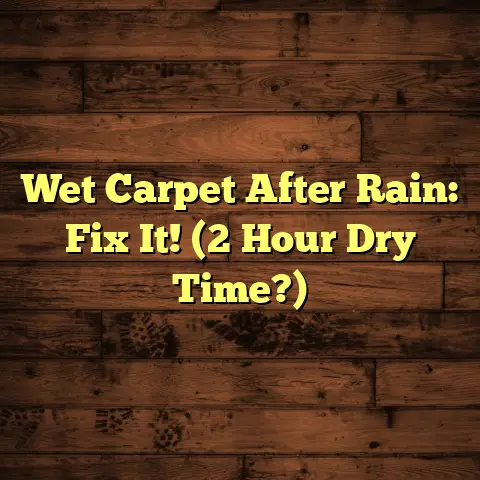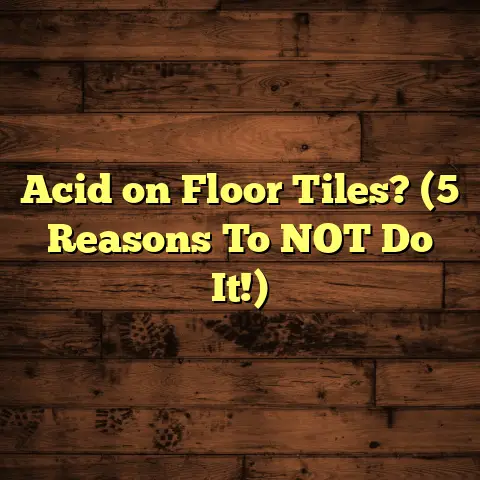How To Wax Wood Floor Scratches: Tips For A Smooth Finish?
Wood floors. They’re the unsung heroes of interior design, right?
I’ve seen them tie together everything from rustic farmhouse kitchens to sleek, modern living rooms.
But let’s be honest, those beautiful surfaces are scratch magnets. And those scratches? They can really throw off the whole vibe, not to mention ding your property value.
That’s why I’m here – to walk you through the process of waxing those scratches away and restoring that smooth, flawless finish we all crave.
Think of this as your comprehensive guide to bringing your wood floors back to life!
Section 1: Understanding Wood Floor Finishes
Okay, before we even think about wax, we need to talk finishes.
It’s like understanding the canvas before you start painting, you know?
1. Types of Wood Floor Finishes
I’ve worked with just about every type of finish out there, and each one has its own personality.
-
Polyurethane: This is your workhorse. It’s durable, water-resistant, and comes in oil-based and water-based formulas. Oil-based poly tends to amber over time, giving a warmer tone, while water-based is clearer and dries faster.
-
Oil-Based Finishes: These penetrate the wood, offering a natural look and feel. Think tung oil or linseed oil. They’re beautiful but require more maintenance.
-
Water-Based Finishes: As I mentioned, these are clear and low-VOC, making them a popular choice for eco-conscious homeowners. They’re not quite as durable as oil-based poly, but they’re getting better all the time.
-
Wax Finishes: Some floors are finished solely with wax. These have a lovely, soft sheen, but they’re the most maintenance-intensive.
The finish affects how the floor looks and how you need to care for it. Waxing complements certain finishes, especially those that are already oil-based or wax-based. It adds a layer of protection and enhances the sheen.
2. Identifying Wood Floor Scratches
Now, let’s get down to the nitty-gritty: the scratches themselves.
Not all scratches are created equal, and knowing the difference is key.
-
Surface Scratches: These are the light ones that just affect the top layer of the finish. They’re usually caused by everyday wear and tear – think pet claws or dragging furniture.
-
Deep Scratches: These go through the finish and into the wood itself. They’re more noticeable and require more attention.
Visual Guide:
- Surface Scratches: Look like faint lines when the light hits the floor. You might not even feel them if you run your hand over them.
- Deep Scratches: You can see the raw wood underneath, and you’ll definitely feel them. They might even have a slightly different color than the surrounding area.
If you’re unsure, try this: dampen a clean cloth and wipe the scratch. If it disappears when wet but reappears when dry, it’s likely a surface scratch.
Section 2: Preparing for Waxing
Alright, you’ve assessed the damage. Now it’s time to gear up!
1. Gathering Necessary Materials
Here’s your checklist for the waxing mission:
- Wax: Paste wax or liquid wax – I’ll break down the pros and cons in a bit.
- Applicators: Cheesecloth, a soft brush, or a foam applicator pad.
- Rags: Plenty of clean, lint-free rags for applying and buffing.
- Cleaning Supplies: Wood floor cleaner, a mop, and a bucket.
- Optional: Mineral spirits (for removing old wax buildup).
2. Cleaning the Floor
Trust me, this step is non-negotiable. You can’t wax a dirty floor!
Dirt and grime will get trapped under the wax, making the scratches even more noticeable.
Here’s my go-to cleaning routine:
- Sweep or Vacuum: Get rid of any loose debris.
- Mop with Wood Floor Cleaner: Use a cleaner specifically designed for wood floors. Avoid anything too harsh or abrasive.
- Rinse (If Necessary): Some cleaners require a rinse. Follow the manufacturer’s instructions.
- Dry Thoroughly: Let the floor dry completely before moving on.
If you have old wax buildup, you might need to use mineral spirits to remove it.
Always test in an inconspicuous area first!
3. Assessing the Environment
Waxing is a bit like Goldilocks – it needs to be just right.
- Temperature: Aim for a moderate temperature, around 60-75°F (15-24°C).
- Humidity: Avoid waxing on extremely humid days. High humidity can affect the drying time and the finish.
- Workspace: Make sure the area is well-ventilated. Open windows or use a fan to circulate air.
Also, clear the area of furniture and anything else that might get in your way. You want a clean, open space to work in.
Section 3: The Waxing Process
Okay, deep breaths. This is where the magic happens!
1. Choosing the Right Wax
Paste wax vs. liquid wax – the age-old debate. Here’s my take:
-
Paste Wax: This is the traditional choice. It’s thicker, provides a deeper shine, and lasts longer. However, it’s also more work to apply and buff.
-
Liquid Wax: This is easier to apply and buff, making it a good option for beginners. It doesn’t last as long as paste wax, but it’s still a great way to touch up scratches.
For scratches, I often prefer paste wax because it fills them in better.
But if you’re new to waxing, liquid wax might be a more forgiving starting point.
How to Choose:
- Floor Finish: If your floor already has a wax finish, stick with wax. If it has a polyurethane finish, you can still use wax, but it’s not always necessary.
- Scratch Severity: For deep scratches, paste wax is your best bet. For surface scratches, liquid wax might be enough.
- Your Comfort Level: Be honest with yourself! If you’re intimidated by paste wax, start with liquid.
2. Application Techniques
Alright, let’s get waxing!
- Apply a Small Amount: Less is more! You can always add more wax, but it’s hard to take it away.
- Use a Circular Motion: This helps the wax penetrate the scratches and blend into the surrounding area.
- Work in Small Sections: Focus on one small area at a time. This gives you more control and prevents the wax from drying out before you can buff it.
- Blend, Blend, Blend: Make sure the edges of the waxed area are blended seamlessly into the surrounding floor. You don’t want any harsh lines.
Pro Tip: If you’re using paste wax, dampen your applicator slightly. This helps the wax spread more easily.
3. Layering
Sometimes, one coat of wax isn’t enough, especially for deeper scratches.
If that’s the case, you’ll need to apply multiple layers.
-
Let it Dry: Allow each layer of wax to dry completely before applying the next. Check the manufacturer’s instructions for drying times.
-
Assess: After the first layer dries, assess the scratches. Can you still see them? If so, apply another layer.
-
Repeat: Repeat this process until the scratches are filled in and the surface is smooth.
Remember, patience is key! Don’t rush the drying process.
Section 4: Finishing Touches
Almost there! Now it’s time to buff and polish your way to perfection.
1. Buffing the Wax
Buffing is what gives your floors that beautiful, smooth shine.
- Use a Clean Rag: Grab a clean, lint-free rag.
- Buff in a Circular Motion: Use firm, even pressure.
- Work in Sections: Just like with waxing, focus on one small area at a time.
- Keep the Rag Clean: As the rag gets dirty, switch to a clean section or a fresh rag.
Optional: If you have a floor buffer, you can use it to speed up the process. Just be sure to use a soft buffing pad and start on a low setting.
2. Final Inspection
Take a step back and admire your work!
-
Check for Consistency: Does the waxed area blend seamlessly into the surrounding floor? Is the shine even?
-
Address Imperfections: If you see any unevenness or dull spots, buff them again. You can also apply a small amount of wax to those areas and buff them again.
-
Look for Missed Spots: Sometimes, you might miss a small scratch. If you find one, repeat the waxing and buffing process on that spot.
Section 5: Maintenance Tips
You’ve restored your floors to their former glory. Now, let’s keep them that way!
1. Routine Care for Wood Floors
- Sweep or Vacuum Regularly: This prevents dirt and debris from scratching the finish. I recommend doing this at least once a week.
- Mop with Wood Floor Cleaner: Use a cleaner specifically designed for wood floors. Avoid harsh chemicals or abrasive cleaners.
- Reapply Wax Periodically: Depending on the traffic in your home, you might need to reapply wax every few months or once a year.
2. Preventive Measures
- Use Rugs: Place rugs in high-traffic areas, like hallways and entryways.
- Use Furniture Pads: Put felt pads under the legs of your furniture to prevent scratches.
- Avoid High Heels: High heels can dent and scratch wood floors. Encourage guests to remove their shoes or wear soft-soled shoes.
- Trim Pet Nails: Keep your pet’s nails trimmed to minimize scratching.
Conclusion
So, there you have it!
Waxing wood floor scratches isn’t rocket science, but it does require a little patience and attention to detail.
But trust me, the results are worth it.
Not only will your floors look beautiful, but you’ll also be protecting your investment and preserving your home’s value.
And let’s be honest, there’s nothing quite like the feeling of stepping onto a smooth, flawless wood floor.
It just elevates the whole space, doesn’t it?
So, grab your wax, roll up your sleeves, and get ready to transform your floors!





